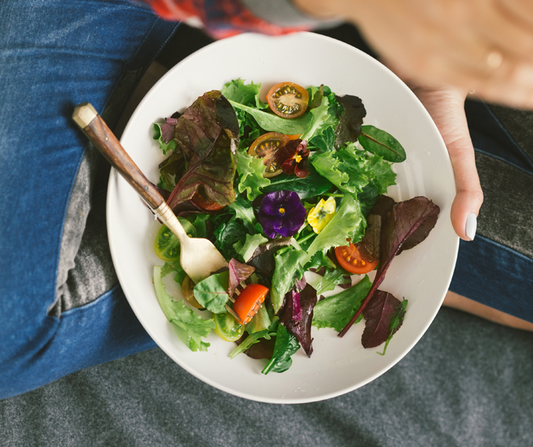THE FIRST STEP IS THE MOST IMPORTANT
Congratulations on taking the first step toward a healthier approach to living! The key to long-lasting health and wellness is maintaining a balance of work and play; eat well, enjoy activities and spend time with friends and loved ones. This guide provides you with useful information on what and how to eat, optimizing your exercise program and making time for mental health and relaxation. As you get started, it may be helpful to plan your daily diet and exercise goals until you forge a system that compliments your lifestyle. Once you have the hang of eating right and exercising regularly, maintaining your new routine becomes easy. This Diet and Exercise Plan should be approached as a lifestyle modification rather than a short term change. Ready, Steady, Go!
ENJOY THE FOOD YOU EAT
When considering a dietary change, the idea isn’t to deprive yourself, but rather learn how to make wise food choices. Once you understand the importance of particular foods and how to incorporate them into your daily life, making healthy food choices becomes easy. In essence, variety is the right idea! Try new foods and explore adding various spices to your diet, such as garlic and cinnamon. Try to keep your plate colorful and experiment with different food textures. Remember healthy food choices is not about sacrifice, it’s about identifying what is the best diet option and changing the way you think and feel about food. For a balanced diet it’s important to incorporate a variety of different foods. Understanding when and what to eat and what would make the most sense in your life is what will facilitate overall success.
WHAT SHOULD I EAT?
Eating is essential and making wise food choices will give your health and your waistline the support it really needs. Whole food is a term used a lot but may not be completely understood. The term refers literally to food in its whole form, with minimal processing to keep it as close to its original form as possible. For example; visualize a whole apple and compare it to a glass of apple juice. The juice on its own does not contain all of the skin, seeds or fleshy center. The whole apple offers all the goodness of the entire fruit and so offers greater health properties. This example applies to most all foods, so choosing whole foods over processed means you get the richest supply of nutrients possible.
Color is important. Antioxidants called polyphenols are responsible for the brightly colored pigments (vibrant reds, greens, blues and purples) of many fruits and vegetables. By keeping your food choices colorful, not only do you get a gorgeous looking meal, but you’ll also benefit from the positive health impact those colorful foods provide.
Enjoy Your Food - The morning meal should be comprised mostly of protein. People mistakenly presume that a carbohydrate breakfast is the best choice. This is partially correct in that carbohydrates such as whole grain cereals are high in fiber which promotes digestive health. However, after fasting for 12 hours overnight, eating carbohydrates only for breakfast results in a glucose surge or sugar spike, followed shortly after by a sugar slump, characterized by low energy and the return of hunger. Energy produced from proteins and fats are delivered in a more sustaining form to avoid drastic spikes and falls in blood sugar. Look to include proteins for breakfast such as yoghurt, turkey sausage and bacon, lean steak, eggs or a protein shake.
WHEN SHOULD I EAT?
Always eat breakfast! Breakfast is the most important meal of the day, after fasting for 8 hours through the night; the body relies on sustenance in the morning for physical and mental energy and focus. Ideally you should eat within an hour of waking to stimulate metabolism and get you going for the day. By not giving your body fuel at regular intervals, every 3-6(max) hours, the body goes into what we call ‘starvation mode’. Starvation mode involves the body hording calories from food into fat cells instead of burning it. In this way, it can be used for fuel when the body goes longer than needed without sustenance. This is why when trying to maintain a healthy weight it’s best to eat small meals every 3 hours (4-5 times per day) to encourage optimal break down of food and stimulate metabolism.
Eating snacks in between meals helps to maintain balanced blood sugar levels and restricts overeating. See the list of ‘healthy snack options’ below for ideas.
The occasional carbohydrate heavy meal such as pasta, rice, breads and potatoes, should only be eaten in the middle of the day, versus in the morning. Try to balance the impact of carbohydrates on blood sugar by adding protein.
Keep your evening meal light and try to eat before 7pm. Your body uses night time sleeping hours to cleanse, restore and rejuvenate the digestive and eliminatory systems. For your metabolism to function at its most efficient, it depends on this nightly restorative process to keep your body operating at optimum levels.
A SUGGESTED MENU PLAN FOR A DAY:
Eat small meals throughout the day to optimize digestive metabolism. This puts less of a burden on your digestive system and allows your metabolism to function more efficiently. Drink a glass of water before meals to decrease the chances of overeating. Keep a supply of low fat healthy snacks around to lessen the chance of falling into bad habits and overeating. Here are some healthy snack suggestions:
- Vegetable sticks with almond butter, hummus, cottage cheese or low-fat ranch dressing
- Rice cakes with avocado or tomatoes
- Raw or roasted unsalted nuts such as walnuts, almonds and brazil nuts
- No added sugar yogurt with fresh fruit
- Low fat cheese with crackers
- Vegetable juice
- Edamame
- Low sodium soup
- Trail mix
BREAKFAST: Bowl of oatmeal, low fat plain yoghurt, 1 cup of berries, 1 cup of low fat milk. 2 slices of turkey bacon, glass of water and cup of green tea.
MORNING SNACK: Half cup of toasted unsalted mixed nuts and a banana. Glass of water. Fruit is the perfect snack! Fruit is full of necessary fiber, energy and nutrients. Try eating a variety of fruits like apples, papayas, plums, melons, grapes, strawberries, pears, peaches, oranges and grapefruit.
LUNCH: Cup of cooked brown rice with baked chicken breast, ¼ cup steamed broccoli and ¼ cup of carrots. Glass of water with lemon. Vegetables provide important vitamins, minerals and fiber so eat in abundance. Other vegetables to include might be spinach, carrots, celery, asparagus and broccoli, avocado, kale and beets. Carbohydrates come in many forms. They help you feel full and provide you with the energy to keep going. Healthy carbohydrate choices include: oatmeal, bran muffins, rice, whole grain bread, quinoa and whole wheat pasta and cous cous.
AFTERNOON SNACK: Glass of water, apple and 1 oz. low fat cheese. Dairy foods help provide necessary calcium and other nutrients, other examples include: goat products, yogurt, milk and cottage cheese. Optimally choose organic products when possible.
DINNER: Glass of water. 3 oz. of Fish (baked with garlic, lemon and ginger and tbsp of olive oil) with salad. Protein helps you maintain good muscle tone and supports a lean physique. Other examples are: lean steak, skinless chicken, fish, beans, eggs, tofu and tempeh. When possible it is ideal to choose organic free range meats and eggs and choose wild caught fish. Tip for cooking protein: baking, steaming or lightly stir frying keeps protein lean and helps to maintain nutrients.
FOODS TO AVOID (keep to a minimum):
- Fried Foods
- Refined sugars
- Carbonated Drinks
- Sodium rich foods
- Highly-processed foods/fast food
REMEMBER: Don’t get discouraged if you eat a food that isn’t the best for you, just remember tomorrow is a new day and a great opportunity to get back on track.
TEN HELPFUL HINTS FOR DIETING SUCCESS:
- Drink eight or more glasses of water a day. Drink at least one glass before every meal. Water helps your body operate at its highest calorie-burning mode and also helps control the appetite.
- Try new foods whenever possible, it allows opportunity to bring variety to your healthy diet.
- Avoid going to a party on an empty stomach. Eat a small salad and drink a glass of water before you go.
- As soon as you are done eating, leave the table so you won't pick at your food and eat more.
- When you eat out, ask for all sauces and dressings on the side.
- Try on new clothes. This is one of the best self-motivating tools you can use to eat right.
- Take only half of what your appetite calls for. You'll be surprised that you may not want a second helping.
- It takes approximately 20 minutes for your brain to recognize that you're full. Eat slowly and chew each bite, chewing is an integral part of the breaking down and metabolism of foods.
- Brush your teeth after eating so you won’t eat anymore.
- Read ingredient labels when grocery shopping. Isolate key information such as saturated fat content, sodium and sugar. Ideally, saturated fat should be under 4gms per serving, sodium under 500mg per serving and sugar no more than 6gms per serving.
HOW TO EXERCISE
Make a commitment to invest at least four hours per week to exercise. Aim for 30-60 minute workouts 3 times per week to support a healthy body and mind. As soon as you feel your enthusiasm decreasing, try a different activity. Team up with a friend. Having a buddy who is committed to a fitness strategy will keep you motivated and increase your chances of success. To achieve a toned, hard-body look, try adding at least two hours a week of free-weight or weight-machine training to your aerobic routine. Lean muscle weighs more than fat, so pay less attention to scales. Exercising in the morning will encourage calorie burning and energy all day long and exercising before meals helps reduce your appetite.
WHICH EXERCISE IS BEST?
Cardiovascular exercises such as jogging, rollerblading, bike riding and basketball stimulates your entire body, encouraging circulation, stamina, heart and lung health, lymphatic drainage and more. It can also help to enhance your mood and focus. Weight-training exercise increases lean muscle mass. Muscle tissue burns calories for energy so the greater amount of muscle tissue you have, the more calories you can burn.
Other forms of exercise like yoga, rock climbing and dancing use many muscle groups as well as encourage deep breathing and stamina.
BELOW IS A SUGGESTED EXERCISE PLAN FOR ONE WEEK:
When getting started set your goals at 15-30min each day and build it up to 30-60min over time.
- Example Week For A Beginner:
- Monday: 30 min brisk walk/jog before breakfast.
- Tuesday: Rest
- Wednesday: 30 min on elliptical machine followed by squats with free weights
- Thursday: Rest
- Friday: Rest
- Saturday: 1 and half hour yoga class or exercise dvd
- Sunday: Rest.
- Example Week For Intermediate Fitness Level:
- Monday: 45 min roller blading before breakfast
- Tuesday: Rest
- Wednesday: 30 min brisk walk and 20 squats before dinner
- Thursday: Rest
- Friday: 1 and half hour bike ride
- Saturday: 1 hour dancing
- Sunday: Rest
- Example Week For Advanced Fitness Level:
- Monday: 45 min run before breakfast
- Tuesday: 1 and half hour spin class
- Wednesday: Rest
- Thursday: 30 min elliptical machine, free weights and 30 squats
- Friday: 30 min run before dinner
- Saturday: 1 hour playing basketball
- Sunday: Rest
"The material on this Total Health Program website is provided for educational purposes only and is not intended as medical, training or physical advice. The information contained in this website should not be used to diagnose , treat or cure any illness, disease or health problem. Always consult your physician or licensed health care provider before beginning any nutrition or exercise program.” Use of the programs, advice and information contained in this website is the sole discretion of the reader.
Questions: Call Nutritional Support 1-800-262-2671 Weekdays 7:15 AM TO 4:15 PM (PST)
Available in Retail Stores Everywhere.


